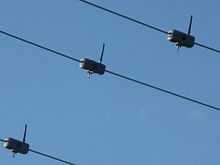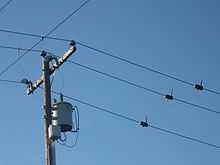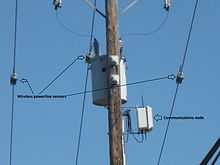Wireless powerline sensor



A Wireless powerline sensor hangs from an overhead power line and sends measurements to a data collection system. Because the sensor does not touch anything but a single live conductor, no high-voltage isolation devices are needed. The sensor is installed simply by clamping it around a conductor. The sensor powers itself from energy scavenged from electrical or magnetic fields surrounding the conductor being measured.[1] With the use of electricity has gone up dramatically over the last few decades. The use in the United States alone at the end of the century was 700 GW. Power is relied upon for so many of our day to day lives, technology, the maintenance of society to function, and our computers or cell phones amongst pretty much everything. The United States or really anyone for that matter can not function without power yet most experience extremely high cost of power. The United States power grid may be the most complex man made systems still to date. Power lines reach exponential amount of distances. The cost to maintain and monitor all of the power lines is overwhelming. Wireless power line sensors provide many solutions and have a very low cost. No batteries are used and very little to no maintenance is required. These sensors need to be resilient to the weather and be smart enough to not have certain levels of current to pass. The weather is unpredictable and so the sensors are designed to handle weather conditions that are certain to happen. The units are painted with liquid silicon to help with weather conditions. They are also designed to not take more current then it can handle causing overheat or malfunction. For example an ambient temperature of 40 degrees Celsius, a wind speed equal to 1.4 mph, and a solar radiation of 1000 W/m2 are levels if reached will keep the line to the maximum current it can hold. Anything above the sensor will know to not allow any more current. The lines also provide great monitoring abilities such as if the power line is sagging, if there is not enough clearance with the ground, if there is a power failure, and if something is making contact with the line itself. In theory once the smart grid has been fully equipped with these sensors their capabilities will increase. They will be able to automatically detect fault with the unit itself, self-reconfiguration to coincide with the patterns of supply and demand. These advanced functions can only exist when all of the sensors are in place to collect and deliver information to each other sensor. SNUPI (Sensor Nodes Utilizing Powerline Infrastructure) are the sensors on the towers in your neighborhood that connect via wire to your home. These nodes contain an ultra-low-power transmitter that extends its range by coupling its wirelessly transmitted signal to the existing powerlines in order to obtain whole-home range. Without them the entire network capacity is limited by a few highly loaded power lines, while the rest of the network remains under-utilized. These nodes increase efficiency and reduces cost. In general the overhead power line monitoring system helps distribution system operators provide reliable service at optimized cost.[2] [3] …
Overhead power line monitoring helps distribution system operators provide reliable service at optimized cost.[2] [3]
A potential harm can come from this technology as individuals may gain access to these sensors containing possible video surveillance that can intrude on one’s privacy, motion detectors with thermal cameras instantly communicating with other sensors, and infrared camera capabilities as well. This would be an ideal way to spy on anyone with an electrical outlet.
Measurements
The primary purpose of a powerline sensor is to measure current, however, they can monitor other operating paramers such as:
- Conductor temperature
- Ambient temperature
- Inclination or the amount of line sagging
- Wind movement
- Electric fields
• Power Generation • Distribution and Consumption of electricity
See also
- Energy management system (EMS)
- Supervisory control and data acquisition (SCADA)
- Wireless sensor network (WSN)
References
- ↑ Yang,, Yi (April 26, 2011), Power Line Sensor Networks for Enhancing Power Line Reliability and Utilization, Georgia Institute of Technology
- ↑ Zhao, X.; Keutel, T.; Baldauf, M.; Kanoun, O. (2013). "Energy harvesting for a wireless-monitoring system of overhead high-voltage power lines". IET Generation, Transmission & Distribution 7 (2): 101–107. doi:10.1049/iet-gtd.2012.0152.
- ↑ Yi Yang; Divan, D.; Harley, R. G.; Habetler, T. G. (2006). "Power line sensornet - a new concept for power grid monitoring". 2006 IEEE Power Engineering Society General Meeting. pp. 8 pp. doi:10.1109/PES.2006.1709566. ISBN 1-4244-0493-2.
4. Casaca, A. ; Pereira, P. ; Buttyan, L. ; Goncalves, J. ; Fortunato, C. A Wireless Sensor and Actuator Network for improving the electrical power grid dependability. Next Generation Internet (NGI), 2012 8th EURO-NGI Conference on 25-27 June 2012, pp 71 - 78. DOI 10.1109/NGI.2012.6252167. Publisher: IEEE
5. Cigdem E., Merve S.,Vehbi Cagri G., Etimad F., Ian F. A. Lifetime analysis of wireless sensor nodes in different smart grid environments. Wireless Networks Volume 20, Issue 7., pp 2053-2062. doi:10.1007/s11276-014-0723-0